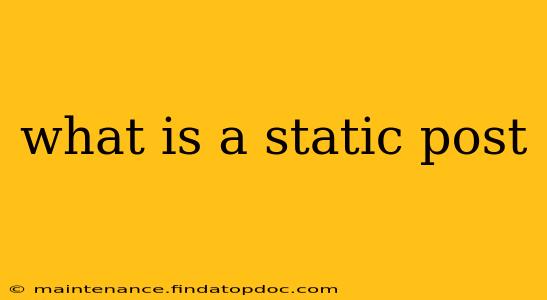In the ever-evolving world of online content, understanding the difference between various content types is crucial. One such type is the static post, a cornerstone of many websites and online platforms. But what exactly is a static post? Let's delve into the details.
A static post is a piece of content that remains unchanged after its initial publication. Unlike dynamic content, which updates automatically (think of a live stock ticker or a news feed), a static post remains fixed unless manually edited. This means the content, its layout, and its overall presentation are consistent over time. Think of it as a digital snapshot of information at a specific point in time.
What are the Key Characteristics of a Static Post?
Several key characteristics define a static post:
- Unchanging Content: The core information within the post doesn't automatically refresh or alter.
- Fixed Layout: The visual presentation of the post—including text, images, and formatting—remains constant.
- Manual Updates: Any modifications require deliberate editing and re-publishing by the content creator.
- No Database Interaction: Unlike dynamic posts that often pull data from a database, static posts exist as independent files. They are usually HTML files.
- Suitable for Evergreen Content: Static posts are ideal for information that doesn't require frequent updates, such as how-to guides, product descriptions, or historical information.
How are Static Posts Different from Dynamic Posts?
The primary difference lies in how the content is generated and managed:
| Feature | Static Post | Dynamic Post |
|---|---|---|
| Content Source | Independent file (usually HTML) | Database or other dynamic data source |
| Content Update | Manual editing and re-publishing | Automatic updates based on data changes |
| Layout | Fixed | Can change based on user interactions or data |
| Example | A blog post about the history of the internet | A live weather report or a social media feed |
What are the Advantages of Using Static Posts?
Static posts offer several advantages:
- SEO Friendliness: Search engines can easily crawl and index static content, leading to better search engine optimization (SEO).
- Improved Website Speed: Static posts generally load faster than dynamic content, improving user experience.
- Simplicity and Ease of Management: They are simpler to create and manage, especially for less technical users.
- Cost-Effectiveness: Often require less server resources than dynamic content, thus reducing hosting costs.
What are Some Examples of Static Posts?
- Blog posts on specific topics: Articles about historical events, product reviews, or in-depth guides.
- About Us pages: Information about a company or individual.
- Contact Us pages: Contact information and forms.
- Frequently Asked Questions (FAQs): Answers to common questions.
- Terms and Conditions: Legal documents.
What are the Disadvantages of Static Posts?
While static posts have many benefits, there are some drawbacks to consider:
- Manual Updates are Required: Keeping information up-to-date requires manual intervention.
- Not Suitable for Time-Sensitive Content: Not ideal for rapidly changing information.
- Content Duplication Can Occur: If you need to make changes, you need to update every single instance of that piece of content.
Are Static Posts Still Relevant in Today's Web?
Absolutely! Despite the rise of dynamic content, static posts remain a vital part of the web. They are particularly suitable for evergreen content—information that remains relevant over time. By understanding their strengths and weaknesses, you can leverage them effectively to create a robust and engaging online presence. Many websites use a combination of static and dynamic content to deliver the best user experience.
